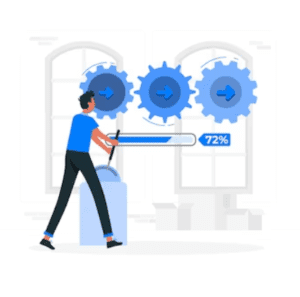Introduction:
Automating the deployment of an application in cloud environments like AWS (Amazon Web Server) and GCP (Google Cloud Platform) can provide a streamlined workflow and reduce errors.
Cloud services have transformed the way businesses work. On the one hand, cloud computing provides businesses with benefits like reduced cost, flexibility, and scalability. On the other hand, it introduced them to a new set of challenges. These challenges can be solved by automation.
Automating Deployment in AWS and GCP

Deployment of applications and services in a cloud-based system can be quite complex and time-consuming. Automating deployment in cloud systems like AWS and GCP can provide a streamlined workflow. In this section, we will discuss the benefits of automation, GCP and AWS tools for deployment, and strategies for automation.
Benefits of Automation in Deployment
Automating deployment provides many benefits. Automation provides greater speed, with automation changes that can be incorporated timely according to the requirements of the market. It will also decrease the chances of the error caused by humans.
Automation also helps ensure consistency in all kinds of environments. Automation also enables organizations to efficiently scale their deployment process without the need for manual labor.
Overview of GCP and AWS Deployment Services
Google Cloud Platform provides many services for automation in deployment. Which includes Jenkins, Spinnaker, Google Kubernetes Engine (GKE), Google Cloud Build, Google Cloud Functions, and Google Cloud Deployment Manager for automating deployment. Each tool has its unique feature.
For example, Jenkins and Spinnaker are used for implementing CI/CD pipelines whereas Google Cloud Function enables organizations to deploy serverless functions.
Amazon Web Server (AWS) also provides several automation services. These services include AWS Elastic Beanstalk, AWS CodeDeploy, AWS CodePipeline, AWS CloudFormation, and AWS SAM. Each service has its unique feature and use case.
For example, AWS SAM provides a framework for building serverless applications and AWS CodePipeline provides a continuous delivery framework for building, testing, and deploying changes.
Strategies for automating deployment

Here are two of the most important strategies for automating deployment in cloud infrastructure.
Infrastructure as code (IaC)
Infrastructure as code (IaC) refers to the practice of managing infrastructure using codes rather than manual processes. This approach enables organizations to handle their applications in an automated, scalable, and efficient environment. Popular AWS and GCP IaC tools include AWS CloudFormation and Terraform.
Continuous integration and continuous deployment (CI/CD)
Continuous Integration and Continuous Deployment is popular software practice to incorporate changes regularly. This allows businesses to test and deploy changes efficiently. Popular CI/CD tools include Jenkins, Travis CI, and CircleCI.
Best practices for Automating Deployment
Here are the best practices for automating deployment in AWS and GCP.
- Continuous Integration and Version controls help organizations build, test, and deploy code changes automatically.
- Infrastructure as Code (IaC) tools like Terraform and many others enable organizations to automate the deployment process. This practice enables organizations to make changes consistently.
- Cloud-based Automated testing enables organizations to identify and troubleshoot problems on time. This practice can save organizations from critical loss.
- Strong security measures ensure that only authorized personnel can make changes to the code.
Scaling in AWS and GCP
Scaling is an important factor in cloud-based systems. It ensures that the application is responsive and reliable. Both AWS and GCP provide businesses with scaling tools that ensure scaling. In this section of the article, we’ll discuss the benefits of scaling in the cloud, an Overview of AWS and GCP tools, and strategies for automating scaling.
Benefits of scaling in cloud environments
Scaling in cloud environments provides many benefits. It helps businesses become responsive to change and rely on the cloud. Cloud services help businesses manage their resources effectively whether it is scaling up or down. It gives businesses flexibility and reduces costs. Businesses can scale up any time they experience high traffic, in the same way, they can scale down anytime they seem to be experiencing issues.
Overview of AWS and GCP scaling services
Both AWS and GCP provide tools and services for businesses to manage the load. These services include auto-scaling, Load Balancing, and many other tools.
Auto Scaling
Both AWS and GCP provide features of auto-scaling. Auto-scaling provides businesses with the opportunity to use any number of resources at a given time. With auto-scaling features, businesses can scale up when they experience peak traffic. Moreover, auto-scaling is also used for cost savings.
Load balancing
Load balancing is another scaling feature provided by both AWS and GCP. The load balancing feature saves from downtime and crashes by distributing traffic. Both cloud platforms offer all types of load balancing including HTTP/HTTPS load balancing, internal load balancing, and network load balancing.
Strategies for Automating Scaling

Automating scaling is very important to ensure organizations are equipped to deal with change. Here are some strategies for automating scaling.
- Utilizing auto-scaling cloud features to ensure that the industry can respond to change quickly.
- Using load balancing features to evenly spread traffic across different servers and prevent downtime.
- Setting auto-scaling feature for specific events when large traffic is expected.
Best practices for automating scaling
Here are the best practices to ensure efficient and effective automating scaling in AWS and GCP.
- Regular testing of scaling should be done to ensure a smooth workflow.
- Infrastructure as Code (IaC) and Continuous Integration and Continuous Delivery (CI/CD) strategies should be utilized to ensure scaling is efficient, consistent, and reliable
- Resources should be monitored regularly to identify problems beforehand.
Comparing AWS and GCP Automation
AWS and GCP are two of the most popular cloud platforms right now. Both cloud platforms offer a variety of tools for automating deployment and scaling. The main difference is in implementation and approach. The choice of the platform depends upon various factors. Read this section carefully to understand those factors.
Similarities and differences in deployment and scaling services
Both AWS and GCP provide a variety of different tools for automating deployment and scaling. All of which we have discussed in the earlier section of the article. Tools and services provided by both of the cloud platforms have the same objective. They only differ in their approach and implementation.
For example, AWS Elastic Beanstalk is a managed platform that automatically handles CI/CD pipelines by itself effectively. GCP’s Kubernetes is a container orchestration system that automates the deployment, scaling, and management of containerized applications.
Comparison of automation strategies in AWS and GCP
Amazon Web Seaver (AWS) and Google Cloud Platform (GCP) offer the same services as we have discussed in the earlier section of the article. The difference lies in the approach. AWS provides a more general approach while GCP provides a more custom approach with their services.
Here is an example of two similar devices of these cloud platforms to signify the difference. AWS Elastic Beanstalk is an automated Deployment service that provides a simplified and mainstream deployment experience whereas GCP provides a more custom deployment approach.
Choosing between AWS and GCP for automation
Both GCP and AWS provide almost the same level of automation services. AWS is more popular and has a mainstream approach while GCP is user-friendly and has a custom approach (i.e open source). The decision to choose between the two depends only on factors like cost effectiveness, reliability, scalability, and the needs of the organization.
Conclusion:
Automating deployment and scaling is an important aspect of software development in the cloud. Automating deployment and scaling provides many benefits including efficiency, reduced cost and error, and less manual labor. In this article, we have discussed the benefits of automation in scaling and deployment, strategies and practices for automated scaling and deployment, and a comparison between both cloud platforms.
Watch the video for an easy understanding of the blog!






